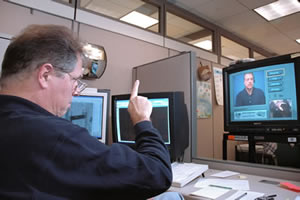 |
|
David Williams, Land Management, uses the video relay system to communicate with a co-worker. Photo by David Gonzalez |
When David Williams, Land Management, needs to talk with his supervisor about a complex work issue, he doesn’t stroll over to his office for a face-to-face conversation. Instead, he picks up the phone and communicates using sign language.
Williams, who is deaf, uses the Video Relay Service for many of his conversations.
A video camera mounted on a monitor on his desk is trained at Williams’ chair. When he wants to use the service, he calls the VRS phone number. A sign language interpreter, also equipped with a camera and monitor, logs into Williams’ profile. The interpreter calls whomever Williams needs to have a conversation with, reads Williams’ sign language and translates it into spoken English for the person on the other end.
The interpreter listens to the response through a headset, and translates into sign language for Williams.
The service allows employees who are deaf or hard-of-hearing to communicate more directly with supervisors and co-workers, make medical appointments and take care of other business. It replaces a relay system that relied on the interpreter and hearing-impaired or deaf employee using a TTY machine that required them to type responses back and forth.
VRS, like the older relay system, is free to users and is funded by Federal Communications Commission charges on monthly phone bills.
“I like VRS a lot better,” said Mike Lalla, Willliams’ supervisor in the Photogrammetrics Unit. “It’s more instantaneous than the older TTY-based communication. There were a lot of pauses with that.”
“With VRS there is no typing – conversation is much more free-flowing,” agreed interpreter number 25, one of the sign language interpreters scattered throughout the country who handles VRS calls.
When a client wants to make a call, they call a central VRS number and the first available interpreter comes on line to assist.
Because the interpreter can see and hear clients, body language, facial expressions and tone of voice can also be conveyed.
Williams says the VRS system is a huge improvement over using a TTY.
“Sign language is my native language,” he said. “VRS makes communication much easier. I can talk to my supervisor and get immediate answers. It has eliminated many communication barriers.
”I have also used it when I needed to communicate with Desktop Support to solve problems with my computer,” he said.
Five VRS systems have been installed in Mn/DOT, says Bruce Lattu, disability programs coordinator, Affirmative Action Office.
VRS is not for every situation, says Lattu. If you need an interpreter for a meeting or face-to-face conversation, you must still use a paid sign language interpreter.
Mn/DOT has a contract for interpretation services; for more information, contact Janet Miller, 651/296-1897. For other disability related accommodations, contact Lattu at 651/296-9742.
By Kay Korsgaard
|



